Until We Meet Again
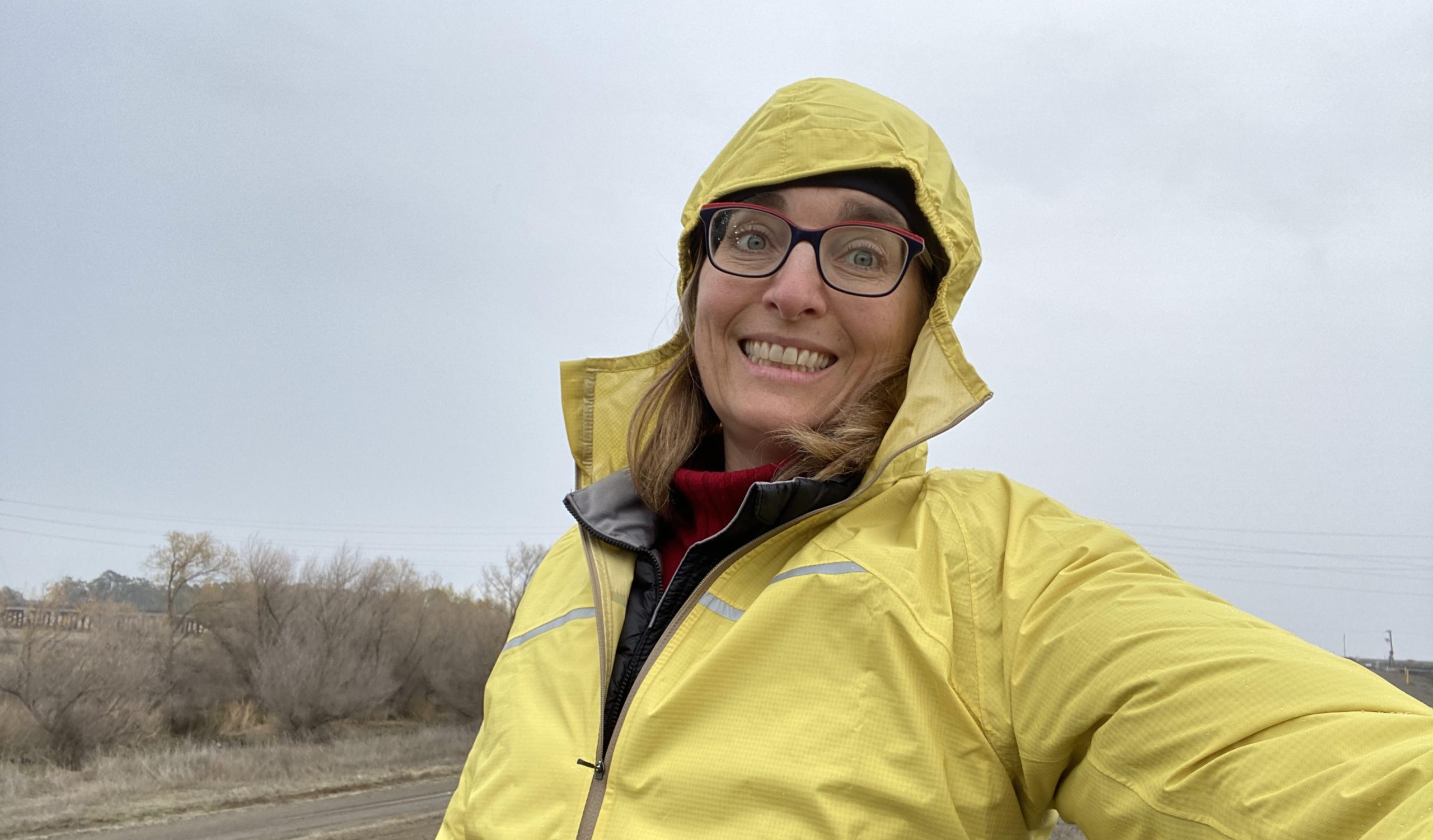
The farewell blog post is a Valley Vision tradition – and a daunting one, now that I’m faced with it myself. My work with Valley Vision, which ends on Friday, includes the last six-and-a-half years as a consultant and employee as well as the decade prior to that (back to about 2004) working as a partner with Valley Vision while at UC Davis and SARTA — spanning, altogether, more than fifteen of the organization’s twenty-five-plus years. How to bid all that work, and all the friends and colleagues I’ve made, farewell in a short blog?
Perhaps by noting that it’s about the work. When we’re fortunate in the work we do, it becomes the embodiment of mission and purpose, and gives meaning to our days – which is what drives us all, at both the individual and the organizational levels, whether in for-profit, not-for-profit, or public service. It’s important to be true to the work. In my two decades here, I’ve done work that’s focused on supporting tech startup companies and the vital contributions of the innovation economy to any region’s economic health and resilience, and I’ve also done work focused on bringing a range of perspectives together around the tough, contentious challenges facing our region. I have been so fortunate to find meaning, purpose, challenge, and reward in all of that work.
And by adding that of course it’s also about the people. The work is only possible because people do it. People show up every day, working mostly together and sometimes at cross purposes; mostly with decent communication and sometimes without; hopefully (but not always) from a basis of trust and with the understanding that everyone is trying to do the best she or he can. And through all that, we understand each other, build friendships, and have fun with each other while also occasionally becoming frustrated by each other. The two decades I’ve been in the Capital Region are the longest I’ve lived anywhere, and all the lines in my life have blurred: my work colleagues have become personal friends; my parent friends have become work friends, my “Davis” friends have become “Capital region” friends, and more. As an introvert and someone who entered working life with bright lines between “work” and “personal,” the blurring of those boundaries has sometimes felt awkward, and has without exception been rewarding.
It’s also about the partnerships. In my experience, when people build partnerships in order to get the work done, the work gets done better. Within a single organization or between several, the ability to find common ground, build a shared agenda, understand what you can each contribute to reaching the goal, and then work together from a basis of trust to do that, while keeping a lid on politics, competition and divisiveness — that’s the sweet spot. That’s the spot I’ve been fortunate to find so often in my work here, whether with Valley Vision, in my own consulting, at SARTA, or at UC Davis. It’s the sweet spot I look forward to continuing to find in what’s ahead.
These are some of the things I’ll take with me when I go, and for which I’m grateful to all my colleagues and friends over all of these years.
So, where am I going, anyway? Thanks to luck, timing, and the ability to leverage so much of what I’ve done and learned in the Capital Region in these years, I’m moving on to become the Senior Vice President of Market Transformation at the Los Angeles Cleantech Incubator (LACI). I’ll help to advance and accelerate the development and deployment of clean technologies of all types, with an emphasis on transportation, energy, and sustainable cities. This new role is exciting because it’s a chance to “live my values” and focus my professional energies on the climate crisis as I’ve hoped to do. It’s also exciting because it joins my prior work with startups and innovation in my SARTA and UC Davis years with my recent work with multi-sector partnerships and policy levers in my Valley Vision years.
So in the end, even though my new work won’t be in this region, I’m only able to do it because of this region. And Valley Vision — its mission, team, Board, regional partners — is where so much of the work, people, and partnerships of these two decades has been centered. To all my Valley Vision colleagues and partners over the years, thank you for so many opportunities, and for all your efforts, wisdom, and friendship.
Meg Arnold has served in several roles during her years at Valley Vision – most recently as Strategic Advisor. She can be reached at meg@gsdconsulting.net.
The Latest on Broadband Coverage in the Capital Region

In November 2020, the California Public Utilities Commission (CPUC) released the latest broadband availability data that reflect broadband coverage in California as of December 2019. This blog will present an overview of the broadband coverage in the Connected Capital Area Broadband Consortium (CCABC) Region, and in the four counties (Sacramento, Sutter, Yolo and Yuba), based on the following speed standards:
- 6/1 Mbps (megabits per second): Current California standard (AB1665).
- 25/3 Mbps: FCC standard. Minimum recommended in a previous blog for households using video conference applications for education or work, and/or having multiple simultaneous users at home.
- 100/20 Mbps: Goal set in the Governor’s Executive Order and the California Broadband 4 All Action Plan.
- 1Gbps/500Mbps: FCC Gigabit service standard.
Based on these standards, the table below presents the coverage and percentage of served and unserved households. At the standard of 6/1 Mbps, the region is at 97.4% coverage (around 17,000 unserved households) which is close to the goal of 98% broadband access in California and in each consortium region. Sacramento has the highest coverage, 97.7%, followed by Sutter, 97%, Yolo, 96.4%, and Yuba, 94.7%. For the 25/3 Mbps standard, the figures are slightly below, achieving a 96.9% in the region (around 20,000 unserved households). At the 100/20 Mbps standard, the regional coverage turns into 93.2%, increasing the number of unserved households to around 44,000. For these three standards, regional coverage is comfortably above 90% coverage, however, for the Gigabit standard, the regional coverage dramatically drops to 22.5% or half a million unserved households.

The figure below shows the layered coverage at the speed standards mentioned above. The higher speeds coverage, 100/20 Mbps and Gigabit (in blue and gray, respectively), is mostly in main urban and densely populated areas across the region. Speeds of 6/1 Mbps and 25/3 Mbps (in light blue and green, respectively) are also available in these areas, and additionally, in suburban and some rural areas. Areas unserved at 6/1 Mbps or with no service are mostly scattered across rural areas across the four counties.
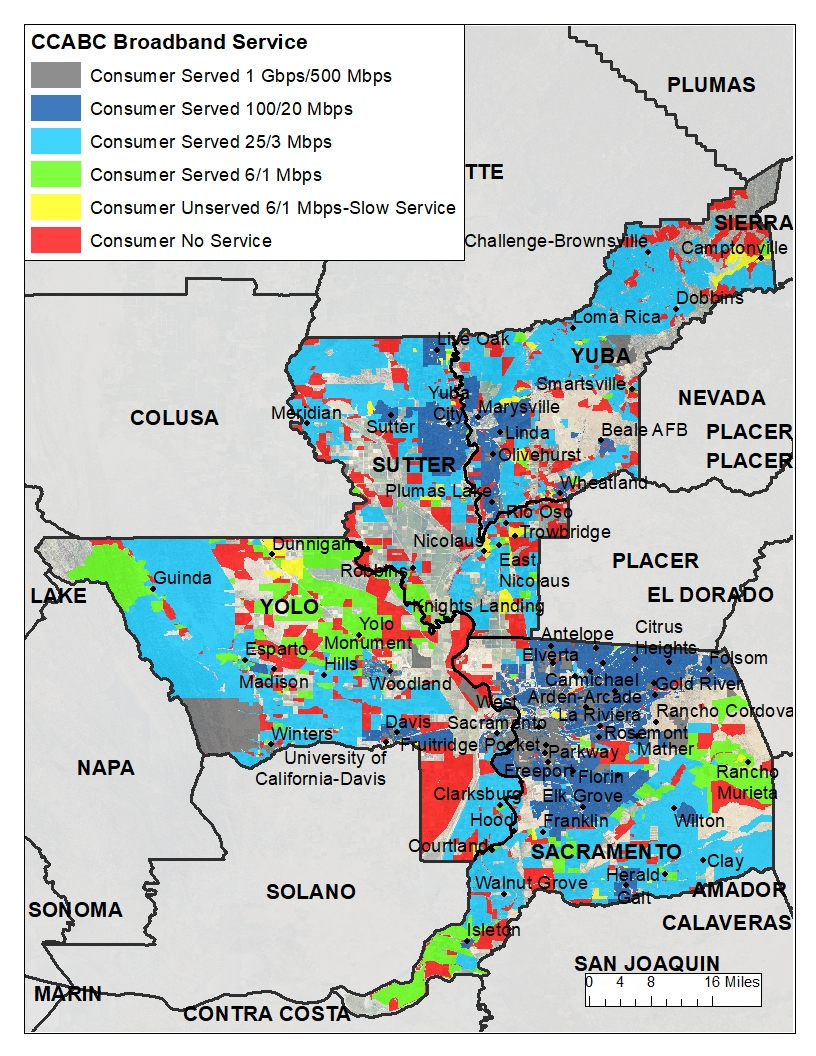
The table and figure below present the broadband coverage by four technologies widely used to provide internet service: DSL, Cable Modem, Fiber to the location (FTTx), and fixed wireless (unlicensed and licensed). Cable Modem has the highest coverage in the region, 94%, and in each of the four counties, followed by legacy DSL, 76%. FTTx achieves a regional presence of around 35%, followed by fixed wireless, 4%. It is important to note that in the figure below, fixed wireless shows the largest footprint in the region, however, this coverage is mostly in less densely populated rural areas. As a result, fixed wireless covers less number of households than the other technologies.
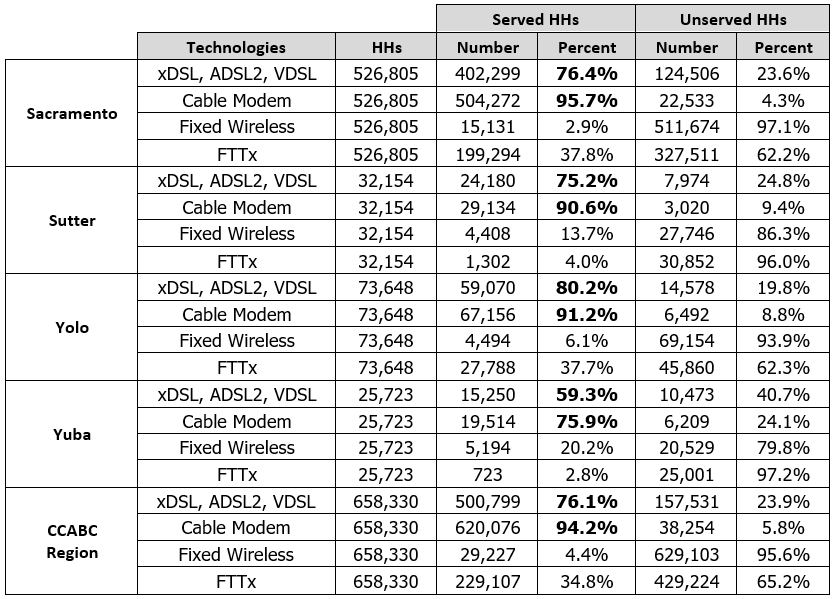
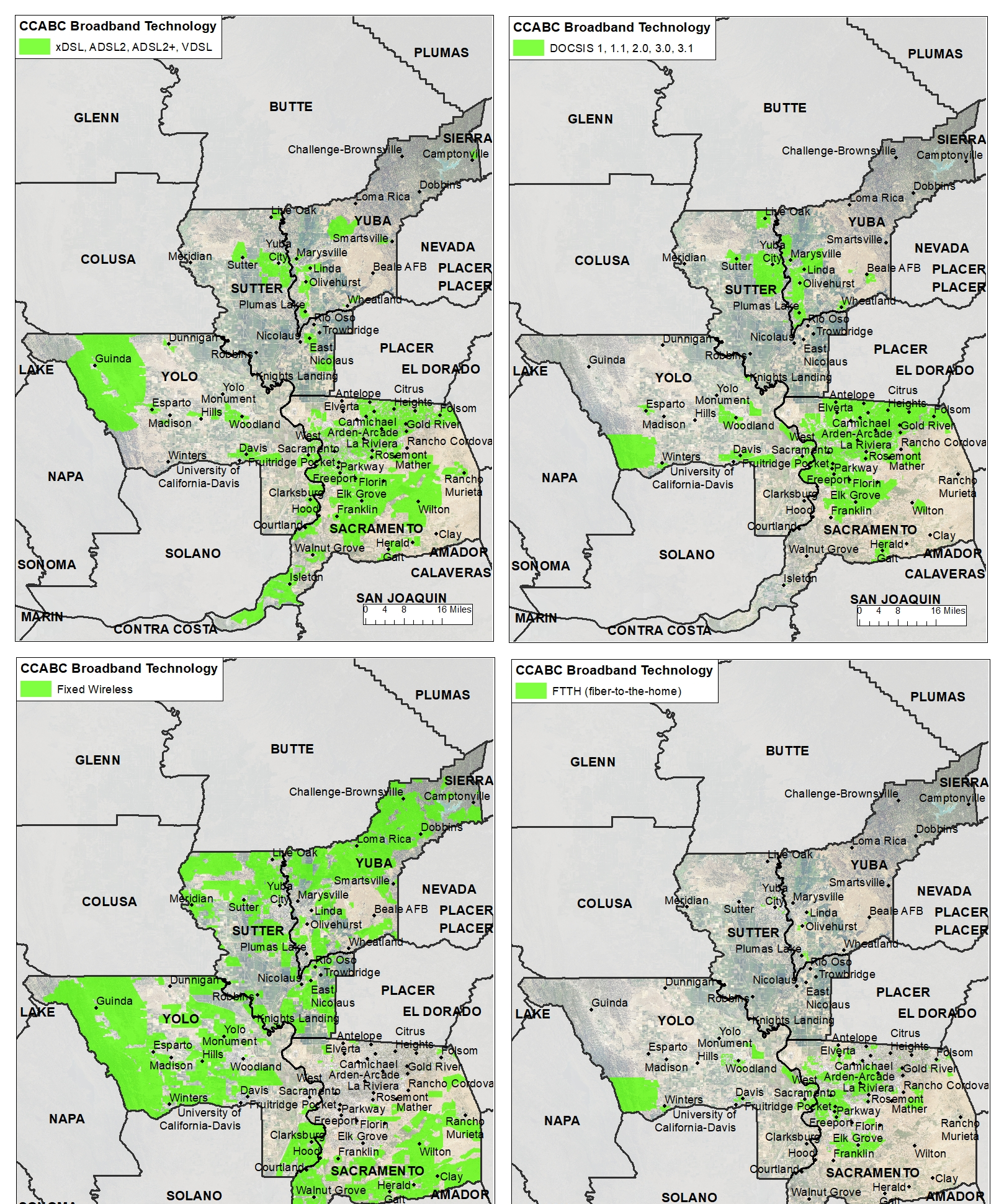
It is important to note that the CPUC broadband availability data is self-reported from ISPs and telecom companies. Many local broadband stakeholders (local governments, communities, residents, and other ISPs) have expressed concerns that some of the data do not reflect what is actually available. For those cases, the CPUC has implemented several validation methods which can be found here. The CCABC recommends internet users to download and run the CalSPEED app (calspeed.org) in order to validate broadband coverage and speeds in the region. In conclusion, these latest CPUC broadband availability figures show that, based on the California 6/1 Mbps standard, our consortium region is still below the 98% availability for households. For the other standards, availability continues dropping to near 93% for 100/20 Mbps, and 22% for an ideal Gigabit service.
This 2021, the Connected Capital Area Broadband Consortium (CCABC) looks forward to continuing working with all broadband stakeholders to get closer to the goal of achieving ubiquitous reliable high-speed and affordable broadband internet for all.
To continue staying up to date with all of the region’s broadband efforts, subscribe to Valley Vision’s e-Connect email newsletter!
David Espinoza is a former Valley Vision Project Leader who managed broadband projects and other initiatives in the Innovation & Infrastructure impact area.
“This Is Not Goodbye, But Thank You”

Being a part of Valley Vision was a turning point in my career. I have waded through non-profit jobs for most of my professional life, picking up different roles every year, finding new ways to expand my skills, but nothing ever felt “right.” After graduating from college, like many young adults, the degree that I spent so many years working to achieve, I thought, was a ticket to that “grown-up job.” The problem was, I had no idea what I wanted to do or what I was genuinely passionate about pursuing. I had spent so much time working to finish my education, I forgot to plan for the rest of my post-academic life.
As I floated in and out of the professional world, I juggled my interest in food systems, agriculture, and community development, trying to find ways to apply all this information I had in my brain to constructive use. I dabbled in the restaurant industry, farmer’s markets, marketing, event planning, university institutions, but nothing seemed to ever fit. Finding Valley Vision was like finding the light at the end of very long tunnel. This was an organization that had not just a fantastic reputation in civic engagement – and food systems – but had a leadership interested in developing and engaging with young professionals. I finally was in a space where I was treated as a qualified individual, and not as a nuisance, but a respected colleague.
Over the last three years, I was given opportunities far beyond what I ever expected, from managing the Farm to Fork Steering Committee to producing conferences like Future Focus to planning and organizing Valley Vision’s 25th Anniversary event. I engaged with regional and national leadership, developed real genuine relationships, had a voice at the table to help solve critical issues, helped provide solutions to issues I was passionate about, and learned about challenges facing communities not just here in the region, but throughout California.
I do not consider my departure from Valley Vision an ending. That is not the Valley Vision Way. Not only will the professional education I was afforded be long lasting, but the relationships built among my mentors and colleagues will be for a lifetime. I probably can never express how much appreciation I have for my time at Valley Vision, but I know that it is because of Valley Vision, its employees, its mission, and culture, that I have the confidence to move forward into this next chapter.
Emma Koefoed was a Valley Vision Project Manager staffing the Food & Agriculture Impact Area and leading Valley Vision event planning from 2017 until the end of 2020. She is the new Manager of Communications & Marketing at the SMUD Museum of Science & Curiosity.
2021: A Time for Courageous Action

January is often when we make predictions for what is to come in the new year. But, if 2020 taught us anything, it is that we are living in an unpredictable world. And given the tumultuous start to 2021, it is likely we won’t be sailing through smooth waters.
With upcoming transfers of leadership, still-record-breaking COVID-19 infection rates, an aggressive national vaccine roll out needed, and with economic recovery and the need for climate resilience at the forefront, we know the 2021 waters will be choppy. Throughout 2020 we talked about the need to reimagine systems that are resilient and equitable. Without courage to take on hard things and focus on tackling complex problems together, we will come out the other side of the pandemic only to recreate inequitable systems that don’t meet the needs of all and can’t adapt to rapid changes that occur in our modern world. Here are some foundational questions and bold ideas from outside our region to inspire us in 2021.
Economic Insecurity
Almost a year into the pandemic, our nation has lost tens of millions of jobs and while there will likely be additional support for small businesses with a new administration, economists have braced us for a slow recovery. Further, with rapidly accelerating changes to our economy and workplaces, many of the lost jobs may be gone permanently. We must push forward innovative and equitable solutions to help people re-enter the labor market. How do we address the dual challenge of the pandemic’s impacts on the economy and the rapidly changing and digitizing workforce? The Aspen Institute has launched a partnership with Mastercard Center for Inclusive Growth to modernize the structure of worker benefits. The program, Benefits21, reimagines a 21st century worker benefits system that provides financial security to all, with a focus on inclusive, portable, people-centric, and interoperable benefits, including unemployment insurance, paid leave, training, and retirement. Additionally, mayors from around the nation are exploring how Universal Basic Income could be a part of a solution to pandemic response and economic insecurity in their communities. Finally, close to home, the Stanislaus Cradle to Career Partnership drives a highly collaborative and robust campaign approach to align institutions to ensure that every child has a path, plan, and a purpose.
Racial Equity
2020 laid bare long term racial inequities and generated an increased sense of urgency to act. How do we move forward with racial equity as a central and driving force in community initiatives? The California Strategic Growth Council is working in collaboration with the Public Health Institute to support the Capitol Collaborative on Race & Equity (CCORE) – a racial equity capacity-building program for California State employees. The program offers cohorts for participants to receive training to learn about, plan for, and implement activities that embed racial equity approaches into institutional culture, policies, and practices. McKinsey offered a data report looking at the role of coalitions in advancing racial equity and W.K. Kellogg Foundation in partnership with Lever for Change is seeking proposals to close the racial equity gap so all children, families and communities can be more confident, healthier and secure in their trust of the systems and institutions that serve them. Registration is due January 28th.
Digital Divide
2020 also made clear the necessity of digital access for all. Over 20 million people across the U.S. lack broadband access- yet connectivity is required for education, jobs, and basic services. How do we rapidly transition infrastructure and services to reflect an economy that requires full digital access? The City of San José, in partnership with the City of San José Mayor’s Office of Technology and Innovation, has engaged the California Emerging Technology Fund to establish the Digital Inclusion Partnership, a $24 million cross-sector fund that will be distributed in grant awards over a ten-year period. It is the city’s largest philanthropic effort in recent history and aims to provide universal connectivity and appropriate digital skills to 50,000 households. This robust effort is a public private partnership and in its first round of rounding will disperse $1M to organizations in San José who are closing the Digital Divide through expanding device access and digital literacy skills.
Housing and Homelessness
Homelessness continues to rise, with a new report from L.A. projecting homelessness doubling by 2023. Additionally, housing affordability challenges have only worsened in 2020 as income loss has occurred and while evictions were avoided, the weight of accumulated rent payments will hit many in 2021. What are the solutions that will help us launch and scale efforts to address housing affordability and homelessness? In Portland, Oregon, Mercy Corps created the Community Investment Trust (CIT) creating a fund that builds the possibility to strengthen communities and create empowered lives. The CIT offers a long-term path to collective, communal ownership of real-estate for investors starting from $10-$100 per month. In Vancouver, the charity Foundations for Social Change (FSC), in partnership with the University of British Columbia gave individuals experiencing homelessness $5,800 with no strings attached and saw very positive outcomes including the attainment of stable, long term housing and food security.
Climate Change
Another aspect of 2020 has been the opportunity to decrease commuting and spend more time in nature for many. Further, COVID-19 response has showed us that we can have the will to move quickly to enact policies and practices for the good of public health. How will we take the lessons of pandemic response and translate them into gains in climate response and resilience? Many cities are taking rapid approaches to increase active transportation, addressing climate change and responding to increased demand for safe walking and biking infrastructure. Paris has demonstrated that cities can go green fast and enact changes that go beyond the pandemic, and Stay Healthy Streets Seattle shows ways that bike lanes are being utilized in ways that improve health and environment.
Addressing these foundational questions for 2021 and learning about initiatives from outside our region inspires us to think differently, take action in new ways, build new types of partnerships, and advance bold solution sets about complex community problems.
Valley Vision supports livable communities in the Capital region by advancing economic prosperity, social equity, and environmental sustainability. We use actionable research, policy education and advocacy, collaboration, and program activation to advance our work. Some key priorities in 2021 will be: enacting a regional agenda for digital inclusion, supporting inclusive economic recovery and growth through Our Path Forward: The Prosperity Strategy, advancing climate resilience, and supporting decision-making with actionable research. Our next Vantage Point will include a focus on inspiring action being taken within our region – there have been a significant amount of that too!
What inspires you for 2021? Let us act courageously together to advance equity, prosperity, and sustainability in our region and in our communities.
To keep up with Valley Vision’s work to advance livability in the Sacramento region, subscribe to our Vantage Point email newsletter!
Evan Schmidt is Valley Vision’s Chief Executive Officer.
What Are You Hopeful for in 2021?

A year of deep challenges has come to an end, and a new year is upon us. Read on for thoughts and predictions that Valley Vision staff hope will come to pass in 2021:
Meg Arnold: “I’m hopeful for transitions: swiftly, to vaccines; smoothly, to the new administration; happily, back to seeing people in person without worry, and (on a personal note) successfully, for the four young adults in our home who will all be starting or resuming their four-year degree programs in the fall.”
Isa Avanceña: “I’m hopeful for opportunities for our communities to come back stronger than ever. It won’t be easy, but I believe our region has what it takes. I’m also looking forward to lots of in-person quality time with family and friends, especially in the second half of the year.”
Kari MacDonald: “I am hopeful that we spend 2021 remembering what is truly important: health, love, family, work-life balance, using technology for connection, and good books!”
Houa Vang: “I am hopeful for great prosperity in health, compassion, and growth for everyone in 2021.”
Grace Kaufman: “I’m hopeful for continued health, colorful sunrises and sunsets, new friendships, and quiet reflection.”
Alan Lange: “Globally, I’m hopeful that everyone will take time to fully appreciate the good things that are in their lives. Personally, I’m hopeful that the deluge of house projects I’ve been assigned by my boss (aka spouse) over the past few months will slow so I can have a free weekend (Love you, K!).”
Evan Schmidt: “I’m hopeful for a better 2021 than 2020! This includes: health and well-being for all, the opportunity to create systems and communities that are better than what came before, the ability to visit family that lives long distance, and to go to a fun party by the end of 2021!”
Trish Kelly: “That 2021 sees restored health; economic recovery and renewal that is truly inclusive, starts to remediate past injustices and structural disparities, and sees our region leading around environmental innovations. And that we will be able to see and hug loved ones.”
Renee John: “I am hopeful we will all be kinder to each other, think of each other first and ourselves less.”
Jesse Flores: “I’m hopeful for the opportunities to channel built-up energy and motivation from 2020 towards a more racially equitable Sacramento region.”
David Espinoza: “I am hopeful to continue witnessing high-quality and affordable internet service expanding across the region. I am hopeful for good health and unity in the country and the world. I am hopeful to become better acquainted with the beautiful and amazing Greater Sacramento Region and for new adventures here with my family. Live long and connected, and may the broadband be with you.”
Adrian Rehn: “I hope for a better and brighter 2021 where people’s basic needs are provided for.”
To keep up with Valley Vision’s work to advance livability in the Sacramento region, subscribe to our Vantage Point email newsletter!
The Year In Broadband…

Broadband has long been recognized as indispensable to equity and economic development. In recent years, significant progress has been made to ensure statewide access. Still, over 8 million California residents do not have broadband subscriptions. We have a long way to go before broadband in California is truly ubiquitous.
In 2020, there has been accelerated momentum around the issue. The onset of the COVID-19 pandemic forced many Californians to pivot some of the most crucial elements of their life — work, school, healthcare, access to services — to an online setting. This shift is an urgent reminder that, in this day and age, broadband infrastructure and adoption is as crucial as roads or electricity.
Valley Vision works with counties, cities, anchor institutions, community groups, businesses, policymakers, and others to bridge the Digital Divide and promote equal access to technology. In 2020, this was embodied in our work contributing to state broadband policy, together with the California Broadband Council, California Forward, the California Emerging Technology Fund, and legislative leaders; our continued role as manager of the Connected Capital Area Broadband Consortium; and our management of the Sacramento Coalition for Digital Inclusion, among others. Broadband infrastructure and adoption is also identified as a high priority of the region’s Prosperity Strategy.
State-level highlights:
- Valley Vision worked closely with California Forward, the California Emerging Technology Fund, and regional broadband consortia to provide input on AB 14, the Internet for All Now Act of 2021. The Bill would authorize the ongoing collection of an existing surcharge on revenues collected by telecommunications providers from customers. The surcharge funds the California Advanced Services Fund, which provides rural and urban communities with infrastructure and other grants administered by the California Public Utilities Commission. This new legislation was announced by Assemblymember Cecilia Aguiar-Curry at the California Economic Summit during a panel on Bridging the Digital Divide, together with Senator Mike McGuire; Trish Kelly, Managing Director of Valley Vision; and Deputy Director Stephanie Tom of the California Department of Technology. Senator Lena Gonzalez introduced similar legislation — SB 4, the Broadband for All Now Act. Both legislators will be principal co-authors on each Bill. This is a major milestone and we hope for quick action in 2021.
- Valley Vision, in collaboration with the California Broadband Council and California Forward, facilitated input for the State’s Broadband Action Plan. An updated draft of the Plan was presented at the Broadband Council’s meeting on Thursday, December 17. The Plan provides a rich overview of the state of broadband across the State, a financial cost model for reaching all Californians with high-speed Internet, and many recommendations for action in 2021.
- Valley Vision co-led this year’s Ensuring Broadband For All working group at the California Economic Summit. The group’s efforts focused on increasing broadband access and adoption in both rural and urban areas. The group developed core principles to drive funding and policy solutions; encouraged collaboration on legislative solutions; supported the State Broadband Action Plan; and worked with the California Public Utilities Commission and others on innovative approaches to infrastructure investment, including leveraging federal resources.
Regional highlights:
- Valley Vision manages the Connected Capital Area Broadband Consortium. Funding for the Consortium was renewed by the California Public Utilities Commission in October 2019, for a three-year period. The Consortium is charged with engaging stakeholders to achieve the broadband connectivity goal of 98% of all households, assisting internet service providers in the region with their California Advanced Services Fund infrastructure grant applications, among other goals. In 2020, Digital Path and Frontier submitted a total of three applications to carry out broadband deployment in Sacramento, Sutter, and Yolo Counties. The Consortium will continue to work with incumbent, competitive, and new entrant internet service providers.
- Valley Vision, together with its partners, finalized and published the Sacramento Region’s Prosperity Strategy — the economic roadmap that ensures a strong, inclusive, and equitable economy. The Strategy calls out broadband infrastructure and adoption, including digital skills acquisition, as high priorities for the region, and was approved by the U.S. Economic Development Administration.
- Valley Vision is working with local government partners in Sacramento, Sutter, Yolo, and Yuba Counties to identify priority areas for broadband expansions or upgrades, including 5G. This includes generating an infrastructure and asset inventory in collaboration with the California Public Utilities Commission, the Sacramento Area Council of Governments, Caltrans, CENIC, the Sacramento Municipal Utility District, the Sacramento Housing and Redevelopment Agency, the Los Rios Community College District, Sacramento State, the City of Sacramento, the Sacramento Promise Zone, among others.
- Valley Vision, the California Emerging Technology Fund, and the Sacramento Area Council of Governments virtually co-convened broadband partners and stakeholders to discuss strategies for accelerating broadband infrastructure investments across the region. The event also showcased highlights of “Getting Connected,” a resource guide for local and regional government leaders featuring best practices, policies, and innovative models to catalyze infrastructure investment and adoption. The resource guide will be rolled out statewide in January 2021.
- Valley Vision put out a Business Broadband Service Survey to assess the current status of broadband service availability and subscription for businesses and community anchor institutions. Results from the survey will help determine and recommend improvements to broadband stakeholders, such as providers and local governments. Outreach for this survey will continue in 2021, through social media, newsletters, and outreach to business chambers.
- Valley Vision launched a campaign — via social media, its newsletters, and outreach to partners and stakeholders — around ground-truth testing of broadband speeds using the CalSPEED app. The app securely tests residential and mobile broadband speeds. Often, the speeds reported by internet service providers are not accurate. Information from the CalSPEED app creates an accurate assessment of actual broadband availability and adoption. Results are used to update the California Public Utilities Commission statewide coverage map and inform infrastructure investments. The campaign resulted in more than 500 CalSPEED tests in our Consortium region. It will continue throughout 2021.
- Valley Vision is completing its Preferred Scenario report for the region, in partnership with the California Emerging Technology Fund. The Preferred Scenario report identifies gaps in broadband deployment and access and the available local assets to address these gaps for the region’s Preferred Scenario corridor — the I -5 corridor. This corridor was identified through the Strategic Broadband Corridors project with Caltrans and the Sacramento Area Council of Governments. This report will identify strategies for leveraging investments.
- Valley Vision, in partnership with the University of California Agriculture and Natural Resources and the National Rural Telecommunications Cooperative, hosted a webinar focused on exploring innovative broadband infrastructure solutions, specifically the co-op model.
- The Federal Communications Commission announced the results of the Rural Digital Opportunity Fund Phase I auction. Winners in our Consortium region (Sacramento, Sutter, Yolo, and Yuba Counties) include Cal.Net, Geolinks, Frontier, LTD Broadband, and Space Exploration Technologies (Space X). Most locations will be receiving broadband with speeds of 100/20 Mbps, and gigabit-speed broadband. Click here to see the map.
Local highlights:
- Valley Vision is developing a Broadband Master Plan for Yuba County, in partnership with the County and Yuba Water Agency. The plan will be completed in the second quarter of 2021.
- Valley Vision is managing the Sacramento Coalition for Digital Inclusion, in collaboration with the city of Sacramento, the Sacramento Public Library, the Los Rios Community College District, California State University Sacramento, and Clear Strategies, among other community partners. The Coalition will be rolling out the 2021 Action Plan for broadband access, adoption, affordability, and digital inclusion and skills, including scale-up opportunities beyond Sacramento County.
- Valley Vision, in collaboration with the Delta Protection Commission, developed a broadband coverage report that will help to identify areas where service most needs improvement. This will empower community leaders and internet service providers to leverage existing opportunities for service expansion and upgrades, and to seek broadband deployment funding.
Valley Vision hosted a webinar on “Community Broadband in Yolo County,” in partnership with the Woodland Technology Alliance. The webinar was a conversation about the current state of the County’s technical infrastructure, as well as solutions to address the community’s broadband gaps. A full recording can be found here, and a summary of the discussion can be found here.
To continue staying up to date with all of the region’s broadband efforts, subscribe to Valley Vision’s e-Connect email newsletter!
Trish Kelly is Valley Vision’s Managing Director, leading its food, agriculture, workforce, and broadband initiatives.
David Espinoza is a Valley Vision Project Leader managing broadband projects and other initiatives in the Innovation & Infrastructure impact area.
Isa Avanceña is a Valley Vision Project Associate supporting the Board of Directors, and the Innovation & Infrastructure and Leadership and Civic Engagement Impact areas.
Building Resilient Skills in the Face of Uncertainty

“Think about it: The pace of change has never been this fast, yet it will never be this slow again.” Justin Trudeau made this statement at the World Economic Forum in Davos in January 2018. In Valley Vision’s 21st Century Workforce impact area, we are seeing the truth of this statement over and over again. The joint pressures of coming out of one of the largest dislocations of workers in our history, the accelerated adoption of automation, and the necessity of determining a recovery strategy inclusive of our region’s diverse workforce combine to require a novel, aligned strategy to prepare our entire population for the Future of Work.
Valley Vision has been working on Future of Work strategies for several years. With funding from the Capital Region’s four workforce boards; Sacramento Employment and Training Agency, Golden Sierra Job Training Agency, North Central Counties Consortium and YoloWorks, Valley Vision has conducted research to anticipate the skills and knowledge needed for the workplace of tomorrow to ensure a ready, regional workforce including producing Automation Risk for Jobs in the Capital Region report. Through funding from the Los Rios Community College District, Valley Vision has convened advisories in specific industry and occupational sectors to identify emerging trends and ensure a workforce that meets employers’ evolving needs.
Recently, through an award from the City of Sacramento CARES funds, Valley Vision was able to embark on a research partnership with Burning Glass Technologies to analyze job posting data to identify transferable, destination occupations for community members laid off from COVID-19. This work builds off the Automation Risk for Jobs in the Capital Region report which looked at the proportion of high risk jobs within the nine county capital region and the demographics breakdown within those jobs.
As the COVID-19 pandemic hit, we saw the jobs identified at highest risk of automation experience the highest layoffs. The correlation of dislocated workers to high automation risk occupations points to the uncertainty of how many original jobs will return and the increasing need to prepare our region’s workforce for more resilient careers, able to withstand advances in automation and other market disruptions. This new research from Burning Glass Technologies identifies the specific skills needed to move job seekers from high risk positions to more stable occupations at similar or higher wages.
This information will be highlighted in a joint webinar with the City of Sacramento as we review the initial research findings. Additional information will be forthcoming, identifying the highest in demand skills for employers in our region. We invite you to stay connected to Valley Vision as we explore the Future of Work together and create pathways for all community members to benefit from our region’s shared prosperity.
To keep up with Valley Vision’s work to advance a future-ready workforce in the Sacramento region, subscribe to our 21st Century Workforce email newsletter!”
Renee John is a Valley Vision Project Leader managing initiatives within the 21st Century Workforce impact area.
A Tense Week

This has been a tense week and there is much that we don’t know. We still don’t know the outcomes of many elections, including who the next U.S. President will be. We also face a higher degree of uncertainty than we normally might after an election season, regardless of the outcomes. There may be tumult as we look into the next few months, with pandemic numbers on the rise, new leaders and policies coming in on national, state, and local levels, and intense community hardships and ongoing divisions occurring in our communities.
There are some things that we do know. We know that the divisions that we see nationally are also reflected here in our region. We see a microcosm of the red and blue patchwork in our region as we do in the nation – with our urban core, including most of Sacramento, Yolo, and Placer counties, leaning Democratic while many of our suburban or rural communities, especially El Dorado, Yuba, and Sutter counties, leaning Republican. Across the region, we see 50/50 splits on liberal/conservative candidates and issues, just like in the nation as a whole. We learned in our recent COVID-19 Resilience Poll that people in the region are losing a sense of goodwill for government and institutions on the national, state, and local levels. So, knowing that uncertainty and division remain, where do we go from here?
We focus on what we know needs to be done and we keep working. We saw from our recent COVID-19 Resilience Poll that people and communities are suffering from the effects of the pandemic – including struggling to afford basic necessities, experiencing depression and anxiety as well as threats to physical well-being, feeling stress from balancing work and home demands, and losing goodwill towards government and institutions. We also know that the effects are being experienced much more intensely for people of color in the region and that younger adults are carrying a heavier burden in many cases.
Beyond knowing that hardships are happening, we also have a sense of where people need support. Affordable housing, access to jobs, extra support for people and businesses who have lost their livelihood, food access, health care access, and broadband connectivity to name a few. Further, we must find the bridges that enable us to work together on the things that matter most. Data-driven action to build common purpose. Listening to and empowering diverse community voices in leadership and decision-making. Holding ourselves and others accountable to address the very real struggles in our communities. Building on our strengths and assets across the region. We know what we need to do, even in the face of political division and possible tumult. Now more than ever, we need to keep working on the issues that matter to build resiliency, equity, health, and prosperity in our communities.
To keep up with Valley Vision’s work to advance livability in the Sacramento region, subscribe to our Vantage Point email newsletter!
Evan Schmidt is Valley Vision’s Chief Executive Officer.
Covid-19 Is Taking a Toll on the Capital Region, Recent Regional Poll Reveals
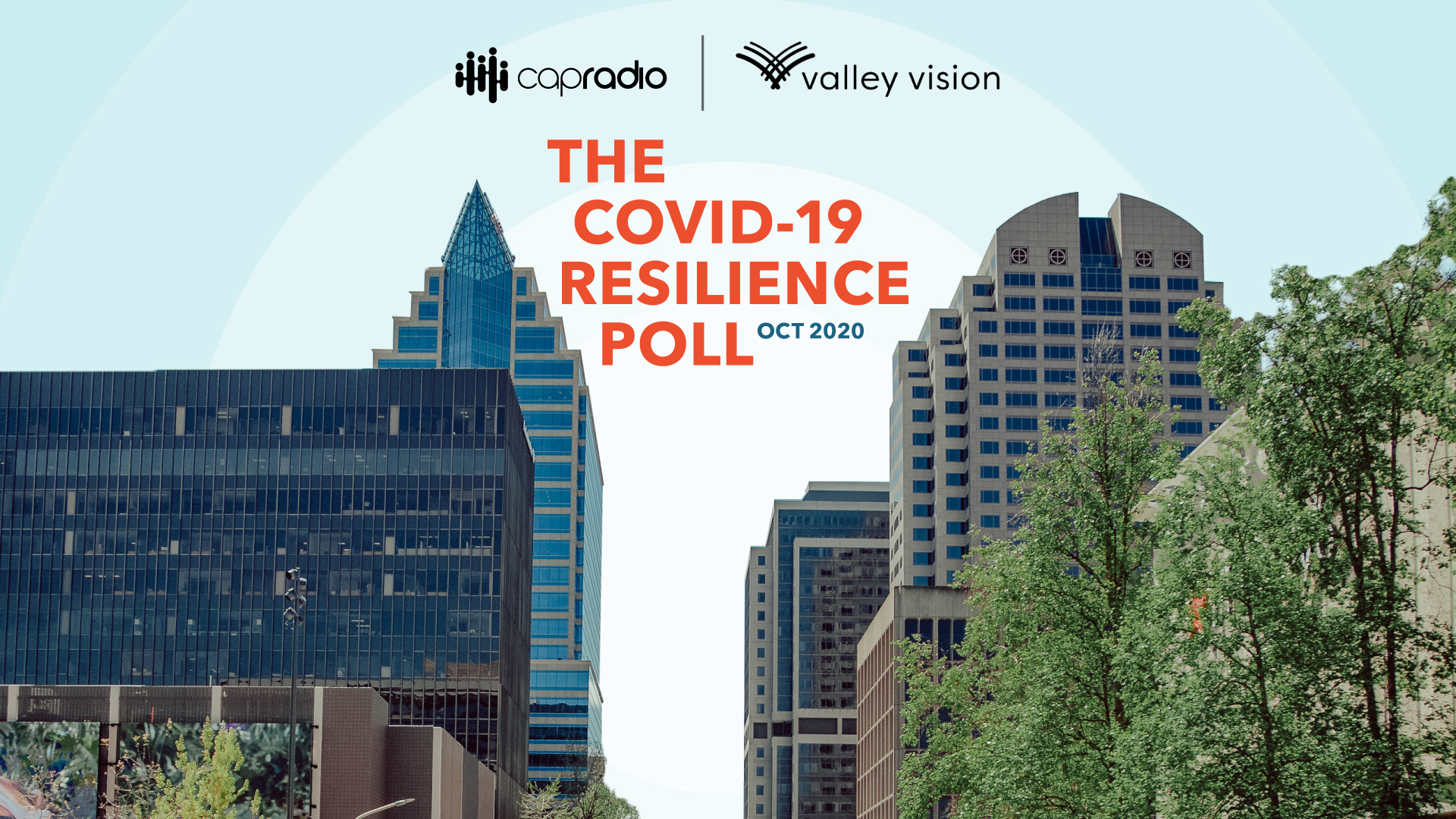
October 20, 2020 – Valley Vision has published the second COVID-19 Resilience Poll this week in partnership with Capital Public Radio. This polling report is focused on understanding experiences, impacts, and attitudes about COVID-19 from residents in our region, and was conducted by the Institute for Social Research at Sacramento State. The COVID-19 Resilience Poll is a demographically representative survey of the eight-county region (Sacramento, Yolo, El Dorado, Placer, Yuba, Sutter, Solano, and San Joaquin) and reported a margin of error of +/-3%. You can find the full COVID-19 Resilience Poll here.
“This survey is the second in our series of three COVID-19 polls. This poll, and the others in the series, tracks how the experiences, perceptions, concerns, and hopes of people in the Capital region are being affected by the COVID-19 pandemic,” noted Evan Schmidt, CEO of Valley Vision. “Having this detailed, data-driven insight about COVID-19’s ongoing impacts on the people and communities we serve is vitally important to our public service mission,” said Jun Reina, executive vice president and general manager of CapRadio, of the partnership with Valley Vision.
The poll results reflect the hardship being felt across the region in the truly hard time we are going through — threats to physical, mental, and emotional health and well-being; income loss and job instability; division in our views about the state of things; and the uncertainties of the future. In most cases, data reported in the first poll, published in July, has continued or worsened in the months since then. For example, nearly half of respondents to this poll said they had lost income as a result of the virus; the same was true in July.
As well, different communities continue to experience markedly different realities. People of color, younger adults, and those earning lower incomes are more likely to have lost income, to report mental health challenges, and to find it very difficult to have children schooling from home, among other impacts. “These disparities are consistent with the data from the first poll, as well as what’s being reported nationwide about what COVID-19 is causing, and the ways in which it’s worsening existing inequalities in our communities,” noted Shannon Williams, executive director of the Institute for Social Research.
Political polarization within the region has increased compared with the first poll. Many respondents are dissatisfied with leadership at various levels, and for different reasons, and that dissatisfaction has grown, and is also more likely, now, to extend to the local level, including local governments, local media, and local businesses.
This poll also reveals evidence of fatigue, including decreases in emotional resilience, diminished trust in institutions, and also declines in some precautionary actions related to COVID. These results may point to people’s fatigue with isolating and also to the daily challenges of the added complexities of life during COVID.
The detailed poll results are accessible in several ways:
- As of today, the complete poll report can be downloaded from Valley Vision’s website: https://www.valleyvision.org/resources/the-covid-19-resilience-poll-2-fall-2020/
- Ongoing coverage from CapRadio can be found at https://www.capradio.org/resilience
- On October 30, Valley Vision will host a webinar providing an overview of the findings: https://us02web.zoom.us/webinar/register/WN_HP97WQ2wT5yeEaMliMUqug
Additionally, Valley Vision’s polling partners have each issued their own press releases.
- CapRadio’s is available on their website: https://www.capradio.org/about/press/2020/capradio-and-valley-vision-release-october-2020-covid-19-resilience-poll-report/
- The Institute for Social Research’s is available on the Sacramento State website: https://www.csus.edu/news/articles/2020/10/20/Pandemic-taking-a-toll-on-family-life,-income,-survey-finds.shtml
About Valley Vision: For 25 years Valley Vision has helped governments, businesses, foundations and community groups better understand our region and its people through high quality research. By uncovering common ground facts using scientific opinion polls, focus groups, community needs assessments, best practice reports and other research tools, Valley Vision is a trusted interpreter, commentator, forecaster and work partner for community inspired solutions.
# # #
Getting Connected in the Capital Region: A Roundtable on Accelerating Broadband Infrastructure Investments

Accelerating broadband infrastructure investment has never been more urgent. Ubiquitous broadband is indispensable to our region’s recovery and resilience in the wake of the COVID-19 pandemic.
On Thursday, October 1, Valley Vision, the California Emerging Technology Fund (CETF), and the Sacramento Area Council of Governments (SACOG) virtually co-convened broadband partners and stakeholders to discuss how to accelerate broadband infrastructure investments across the region. The event also launched highlights of “Getting Connected,” a resource guide for local and regional government leaders to deploy 21st century broadband infrastructure. As manager of the CPUC-funded Connected Capital Area Broadband Consortium (CCABC), Valley Vision partnered with CETF on preparing this leading-edge resource guide, which features best practices, policies, and innovative models to accelerate broadband infrastructure investment and adoption.
Trish Kelly (Managing Director for Valley Vision) and Sunne McPeak (President and CEO of CETF) began the event with welcome remarks. They provided an overview of the CCABC mission; the Greater Sacramento Region Prosperity Strategy’s broadband infrastructure, access, and adoption priorities; Valley Vision and CETF’s Preferred Scenarios work identifying unserved communities, available public assets, and funding needs; as well as major new opportunities in the broadband space, following the Governor’s Executive Order N-73-20 for the California Broadband Council to create the California Broadband for All Plan by the end of the year.
Dr. David Espinoza (Valley Vision’s Project Lead for Innovation and Infrastructure) emphasized the need for increased investment in broadband. Espinoza did a deep dive into new data he generated estimating the cost of filling broadband gaps in the CCABC Region to achieve the State’s goal of 98% broadband service connectivity for households. The presentation featured coverage maps at different speed thresholds, and the methodology to calculate the cost per household for technologies such as fiber-to-the-home and fixed wireless in different geography and terrain scenarios.
Next, Isa Avanceña (Project Associate at Valley Vision), presented an overview of the Resource Guide. The Guide includes an overview of select broadband plans and ordinances across the State; case studies for broadband deployment and adoption; and a list of additional resources from national and state broadband agencies and organizations. It covers crucial topics such as broadband master plans, Dig Once/”Dig Smart” policies, municipal fiber to the premises, master license agreements, and 5G. The Resource Guide is being finalized, and will be released and widely disseminated in November.
The event also brought together regional internet service providers and local elected officials in a two-part roundtable. Espinoza facilitated a roundtable discussion with a panel of Internet service and broadband infrastructure providers that included Crown Castle, Digital Path, GeoLinks, Zayo, and T-Mobile. In their discussion, the panelists identified what they need from jurisdictions in order to reduce the barriers to broadband infrastructure and deployment, as well as some of the best practices that they’ve come across currently being implemented in some cities and counties. Kelly facilitated a roundtable discussion with a panel of local elected officials: Mayor Pro Tempore Tom Stallard of the City of Woodland, Supervisor Don Nottoli of Sacramento County, and Supervisor Gary Bradford of Yuba County. They highlighted some of the challenges they face in getting fast and reliable internet access to all communities in their jurisdictions, and the solutions that they’d like to pursue to move the needle on the issue.
The event generated a lot of momentum to accelerate partnerships and investments across the Capital Region, with collaboration and communication being two actions identified by all as essential to economic recovery and progress. Valley Vision thanks CETF for its continued support of our mission, and thanks all who participated; we look forward to advancing timely and effective solutions with our partners across the region.
Event materials are available on the Valley Vision website, and provide more detailed information on the subject matter and outcomes:
This blog focuses on just some of the updates at the state, county, and local level. To continue staying up to date with all of the region’s broadband efforts, subscribe to Valley Vision’s e-Connect email newsletter!
The First 90 Days

As of this week, I’ve been in the position of CEO of Valley Vision for 90 days – which is often counted as a milestone for a new job. During these 90 days I’ve focused on learning the job; engaging with community partners, stakeholders, Board, and staff; and developing a set of priorities for Valley Vision into 2021. What is my vision for Valley Vision?
1. Deepening Our Commitment to Social and Racial Equity
My career focus has always been on strengthening equity in communities – from early in my career working on gender equity to the many projects I’ve advanced at Valley Vision that create equitable opportunities. As CEO, it is important to me that Valley Vision’s commitment to social and racial equity be authentic and apparent through our actions. In July, the Valley Vision staff team participated in a Whiteness at Work web series to examine how dominant white culture and anti-Black culture impacts our staff, teams, and work in and for the community. We ended the series with new resources, a new staff-led Equity Subcommittee, and an identified set of actions to cultivate inclusion and equity within our staff and through our work. We are starting with ourselves – building trust, team cohesion, and a common set of values that are foundational to our work. Our goal is to develop our own framework to advance operationalizing equity in our organization and throughout our work.
2. Visionary Planning and Investment Strategies
Valley Vision’s role in the region is to set our eyes on long-term solutions to create economic prosperity, social equity, and environmental sustainability in the region. To do this, Valley Vision is known for advancing research, fostering collaboration, and catalyzing action. We also need an engine to achieve needed investment to solve our region’s larger challenges. Therefore, Valley Vision is engaging in more intentional investment planning including working with community leaders and partners to create comprehensive, co-designed strategies which will create project and investment-ready coalitions to advance bold solutions. We have an opportunity to meet our region’s greatest challenges together through ambitious, co-owned solutions that will position our region as one of the most livable in the nation.
Our first focus is on developing an investment strategy to advance digital inclusion in the region by expanding broadband infrastructure and connectivity, supporting access to needed technology for all, and advancing digital skills for the workforce. We are already co-leading the Sacramento Coalition for Digital Inclusion with other partners to create the systems, tools, and skills needed for all to fully participate in civic life, education, and work. Reaching our long-term solution to truly create digital equity in the region will require a big-umbrella vision to inspire investment — because if we don’t know where we are going, how will we get there?
3. Creating Actionable Research and Sharing Our Insights
Our region and communities are transforming more rapidly than in generations. Between coronavirus, effects of climate change, upcoming elections, the pace of technology change and adaptation, and more – life has never been so complex. That is why it is more essential than ever to have the data and information needed to adapt, recover, and reimagine our future. There are a few main areas where we will grow our research capacity by focusing on actionable research and advancing a commitment to sharing best practices.
- Actionable Research: We believe that decisions should be informed with data and we are expanding our capacity to create actionable research. We have already built two new partnerships in the last six months to be able to do just that – Capital Public Radio for our polling initiative and Burning Glass Technologies to analyze rapidly changing workforce needs. We’ve also hired Dr. David Espinoza to manage the Connected Capital Broadband Consortium – bringing his GIS and other analytical expertise to our team.
- Sharing Lessons Learned: Valley Vision’s ability to collect and analyze unique data for the region is one of our key strengths. We generate a tremendous amount of data and lessons learned at Valley Vision, but it has not always been our regular practice to slow down in order to share the unique data and the stories from the field that we have collected. I’m very committed to reporting out regularly as well as connecting with other publications and networks to share our work, insights, and recommendations.
The Valley Vision I envision is an inclusive organization with clear values around equity; is action-oriented, collaborative, and poised to do big things; and is always pushing forward to find new information, connect the dots, and support data-driven decision-making in our region. Let’s get to work.
To keep up with Valley Vision’s work to advance livability in the Sacramento region, subscribe to our Vantage Point email newsletter!
Evan Schmidt is Valley Vision’s Chief Executive Officer.
Highlighting Sacramento Region Digital Inclusion Efforts
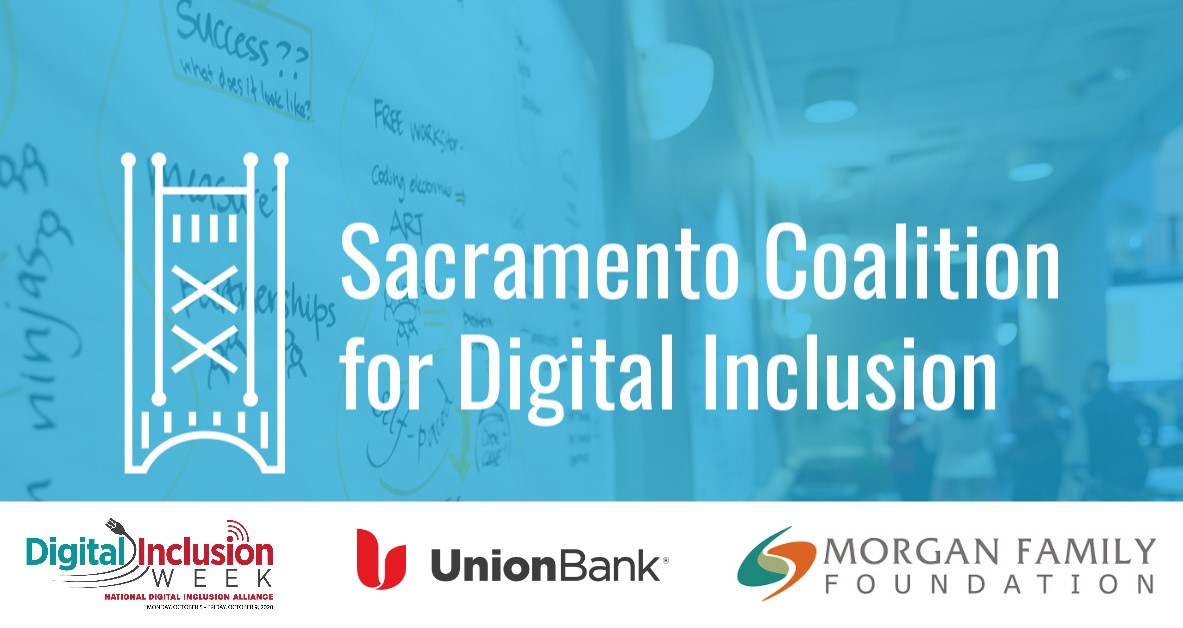
There has never been a more critical time for discussion of digital inclusion which has recently been referred to by the Center for Public Integrity as the “civil rights issue of our time.” As the Pandemic has upended education and workforce, it has left in its wake a widening chasm between community members with resources and those without. In recognition of National Digital Inclusion week, Valley Vision highlights the history, continuing collaborative work, and new momentum of the Sacramento Coalition for Digital Inclusion, a regional approach to creating more opportunities for digital equity.
Discussion which formed the beginnings of the Sacramento Coalition for Digital Inclusion began in the fall of 2018 inspired by a Brookings Institution report on the strengths and weaknesses of the Sacramento Capital region. A series of community discussions occurred to organize around the mission of digital equity, with the Sacramento Public Library hosting the Sacramento Digital Inclusion Summit in January 2019. This led to the creation of the Sacramento Coalition for Digital Inclusion, with more than 40 members, led by a Steering Committee comprised of the City of Sacramento, the Sacramento Public Library, Valley Vision and Social Ventures Partners. During 2019, the Coalition built collaborative relationships, conducted assessments of needs including through community engagement, and produced an initial report focused on increasing digital access, both to affordable Internet and devices, and digital literacy/skills. The City of Sacramento passed a resolution in October 2019 to launch National Digital Inclusion Week in the region.
With the onset of the Pandemic, the work of the Coalition became even more important and the need for a funding mechanism to drive forward momentum and staff this increasingly important body of work required an urgent solution. Valley Vision has been successful in securing short term funding to continue and expand this valuable work through the Morgan Family Foundation and Union Bank, on behalf of community partners and stakeholders.
Current Coalition Steering Committee members include the City of Sacramento, the Sacramento Public Library, and Valley Vision, joined by representatives from Los Rios Community College District and California State University Sacramento, with the Coalition being a vibrant group of over 60 community members and leaders. Three working groups were successfully relaunched in a well attended September Coalition meeting to establish key objectives and drive the work plan of the Coalition in the areas of Internet Access and Adoption, Technology Devices, and Digital Literacy/Digital Skills.
Valley Vision is thankful to the dedicated efforts of the Steering Committee and all members committing their time and talent to align and drive investment in a regional and sustained response to urgent digital inclusion needs. We invite you to join in this work at our next Coalition meeting on October 23rd 11 am to 12:30 pm and help us build a regional digital inclusion work plan to address disparities throughout our region and build a better future for all.
Sacramento Coalition for Digital Inclusion Steering Committee:
- Aubrey Taylor, City of Sacramento
- Jarrid Keller, Sacramento Public Library
- Karina Talamantes, City of Sacramento, Sacramento County Board of Education
- Kevin Flash, Sacramento City College
- Tamara Armstrong, Los Rios Community College District
- Dr. Yvonne Harris, California State University Sacramento
- Trish Kelly, Valley Vision, Managing Director
- Renee John, Valley Vision
- Dr. David Espinoza, Valley Vision
- Jesse Flores, Valley Vision
To keep up with Valley Vision’s work to advance a future-ready workforce in the Sacramento region, subscribe to our 21st Century Workforce email newsletter!”
Renee John is a Valley Vision Project Leader managing initiatives within the 21st Century Workforce impact area.